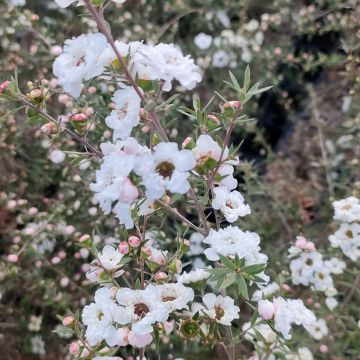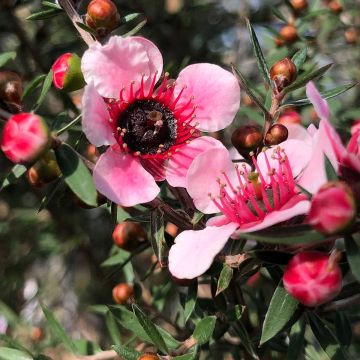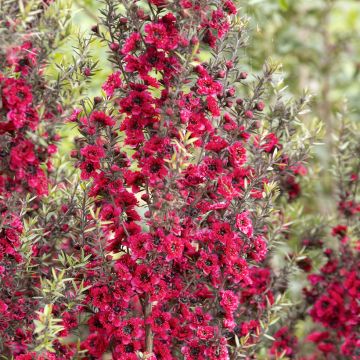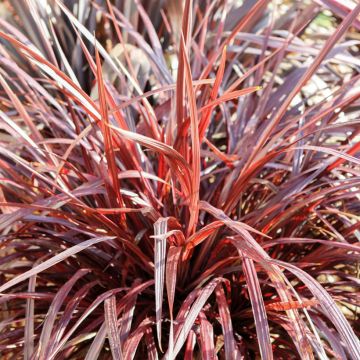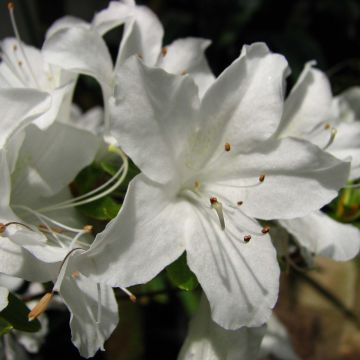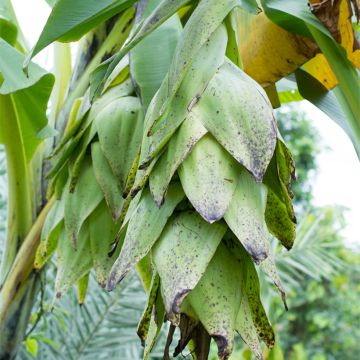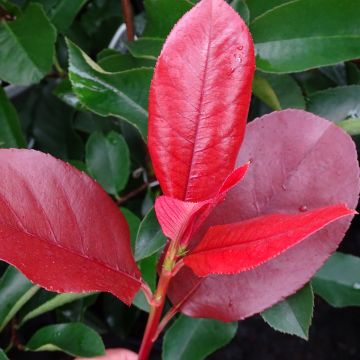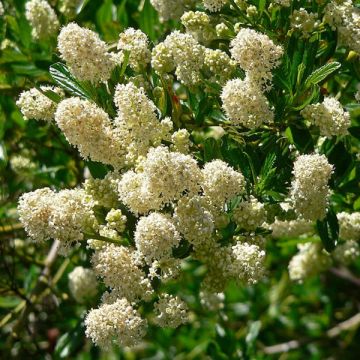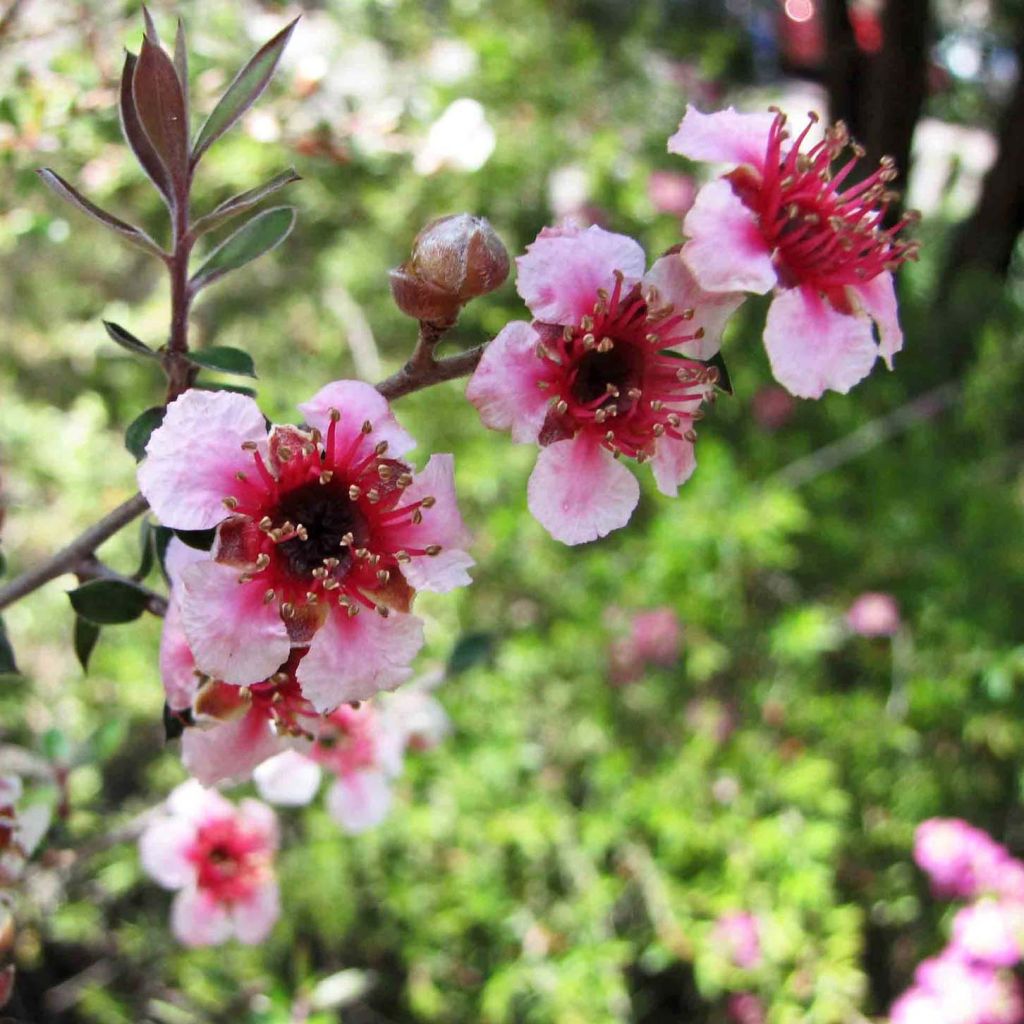

Leptospermum lanigerum Mesmer Eyes - Arbre à thé
Leptospermum lanigerum Mesmer Eyes - Woolly Tea-tree
Leptospermum lanigerum Mesmer Eyes
Woolly Tea-tree, New Zealand Tea tree, Manuka
Perfect! The delivery went well, the young plants were very well packaged, without all the plastic that was there before (it's very pleasant) and they arrived with lots of flower buds that are just waiting to bloom! I planted them immediately in partial shade. Thank you very much!!!
Marianne, 31/03/2023
Special offer!
Receive a €20 voucher for any order over €90 (excluding delivery costs, credit notes, and plastic-free options)!
1- Add your favorite plants to your cart.
2- Once you have reached €90, confirm your order (you can even choose the delivery date!).
3- As soon as your order is shipped, you will receive an email containing your voucher code, valid for 3 months (90 days).
Your voucher is unique and can only be used once, for any order with a minimum value of €20, excluding delivery costs.
Can be combined with other current offers, non-divisible and non-refundable.
Home or relay delivery (depending on size and destination)
Schedule delivery date,
and select date in basket
This plant carries a 24 months recovery warranty
More information
We guarantee the quality of our plants for a full growing cycle, and will replace at our expense any plant that fails to recover under normal climatic and planting conditions.
Would this plant suit my garden?
Set up your Plantfit profile →
Description
Leptospermum lanigerum Mesmer Eyes is a variety of New Zealand tea tree rich in qualities: this beautiful bush is dressed in fine evergreen foliage of silver-green, decorative throughout the year. It has a bushy habit and is adorned with a multitude of small flowers blooming all along its branches from spring to summer. They shift from white to pink in two tones, creating a beautiful bicoloured effect. It's an excellent plant for borders in mild climate, less demanding and more hardy than most other Leptospermum. This bush will flourish very well in a large pot on the terrace, which allows it to be sheltered from heavy frost in cold climates.
Leptospermum Mesmer Eyes is a horticultural variety derived from the L. lanigerum var. lanigerum, a botanical species called woolly tea tree that is native to the coastal mountains of New South Wales, Queensland, Victoria and Tasmania, and from which this bush gets its small silvery leaves. Leptospermum are cousins of Mediterranean myrtles, clove tree and Eucalyptus. They belong to the same family of Myrtaceae, and share with these plants a love of heat and a good tolerance to dry and poor soils. With a bushy and compact habit, 'Mesmer Eyes' will reach on average 1.20 m in height and 1 m (3 ft) in width at maturity. It has alternate, single, slender, small-sized leaves, white at budburst, later taking a green hue somewhat masked by silver bristles that give them this somewhat downy appearance. The whole leaf shows a green-grey colour with a silver sheen. The flowers, single, honey-rich and full of nectar, appear during 5 to 6 weeks from April to July depending on the climate. They are composed of 5 petals surrounding a very dark purple-pink heart and can reach 2 to 3 cm (0.8 to 1.2 in) in diameter. The petals are white at first, then they gradually turn fresh pink. This bush can be pruned lightly after flowering from May to July. It can withstand temperatures down to around -10°C but the aerial parts can be damaged from -8°C. It needs a well-sheltered spot, in full but not scorching sun.
The 'Mesmer Eyes' tea tree tolerates sea spray well and appreciates sandy soils, making it a very beautiful bush for seaside gardens. Install in a border or bed alongside other Australian or New Zealand bushes such as Callistemon, Grevillea, Melaleuca, but also with South African species: Gomphostigma White Candy, Dierama, Aloe arborescens, Anisodontea capensis or Melianthus major should enjoy the same growing conditions. In regions with very cold winters it should be grown in a pot and kept frost-free throughout the winter.
Leptospermum means "thin seed" and gets its common English name of tea tree from Captain Cook and his crew, who used its leaves to prevent scurvy.
Report an error about the product description
Leptospermum lanigerum Mesmer Eyes - Woolly Tea-tree in pictures
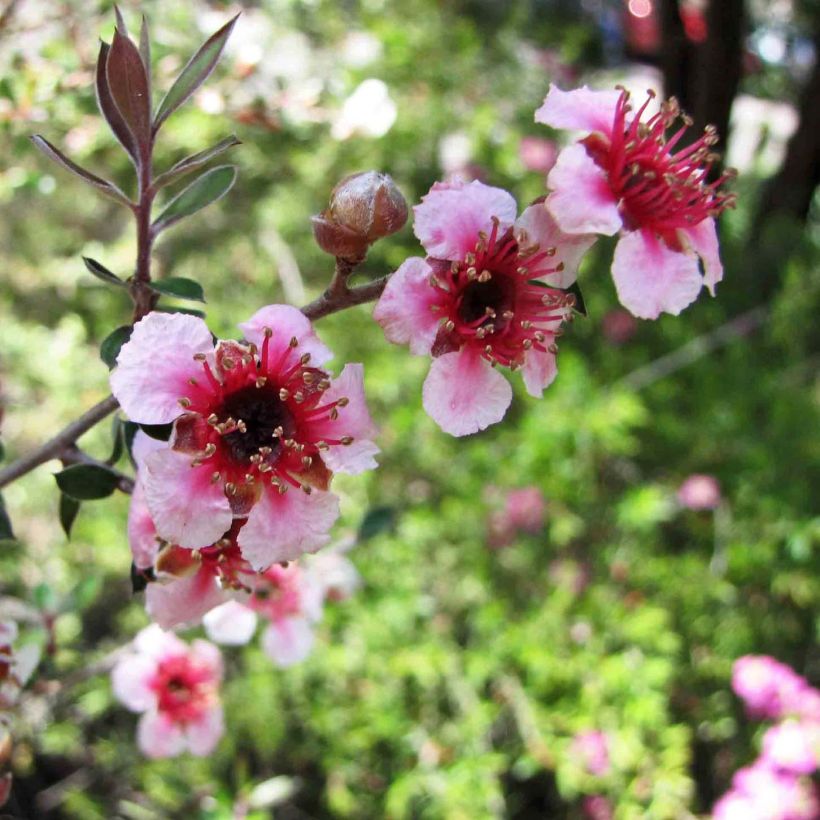



Plant habit
Flowering
Foliage
Botanical data
Leptospermum
lanigerum
Mesmer Eyes
Myrtaceae
Woolly Tea-tree, New Zealand Tea tree, Manuka
Cultivar or hybrid
Other Leptospermum
View all →Planting and care
Leptospermum Mesmer Eyes, hardy down to -10/-12°C at best, will need protection from cold North and East winds during very cold winters. It prefers draining to dry, light, loamy or sandy soils, with a neutral or slightly acidic tendency, but is generally quite tolerant. Choose a partially shaded site in a warm climate, or a sunny one in a cooler climate. Prune lightly after flowering (do not remove more than 1/3 from the length of the branches), to maintain a compact habit. In spring it will appreciate an input of nutrients (compost, manure), even if this is not essential, as Manuka is adapted to rather poor soils. Allow the surface of the root ball to dry between watering and reduce watering in autumn as soon as the temperatures drop. Preferably use only slightly or non-calcereous water.
Planting period
Intended location
Care
-
, onOrder confirmed
Reply from on Promesse de fleurs
Similar products
Haven't found what you were looking for?
Hardiness is the lowest winter temperature a plant can endure without suffering serious damage or even dying. However, hardiness is affected by location (a sheltered area, such as a patio), protection (winter cover) and soil type (hardiness is improved by well-drained soil).

Photo Sharing Terms & Conditions
In order to encourage gardeners to interact and share their experiences, Promesse de fleurs offers various media enabling content to be uploaded onto its Site - in particular via the ‘Photo sharing’ module.
The User agrees to refrain from:
- Posting any content that is illegal, prejudicial, insulting, racist, inciteful to hatred, revisionist, contrary to public decency, that infringes on privacy or on the privacy rights of third parties, in particular the publicity rights of persons and goods, intellectual property rights, or the right to privacy.
- Submitting content on behalf of a third party;
- Impersonate the identity of a third party and/or publish any personal information about a third party;
In general, the User undertakes to refrain from any unethical behaviour.
All Content (in particular text, comments, files, images, photos, videos, creative works, etc.), which may be subject to property or intellectual property rights, image or other private rights, shall remain the property of the User, subject to the limited rights granted by the terms of the licence granted by Promesse de fleurs as stated below. Users are at liberty to publish or not to publish such Content on the Site, notably via the ‘Photo Sharing’ facility, and accept that this Content shall be made public and freely accessible, notably on the Internet.
Users further acknowledge, undertake to have ,and guarantee that they hold all necessary rights and permissions to publish such material on the Site, in particular with regard to the legislation in force pertaining to any privacy, property, intellectual property, image, or contractual rights, or rights of any other nature. By publishing such Content on the Site, Users acknowledge accepting full liability as publishers of the Content within the meaning of the law, and grant Promesse de fleurs, free of charge, an inclusive, worldwide licence for the said Content for the entire duration of its publication, including all reproduction, representation, up/downloading, displaying, performing, transmission, and storage rights.
Users also grant permission for their name to be linked to the Content and accept that this link may not always be made available.
By engaging in posting material, Users consent to their Content becoming automatically accessible on the Internet, in particular on other sites and/or blogs and/or web pages of the Promesse de fleurs site, including in particular social pages and the Promesse de fleurs catalogue.
Users may secure the removal of entrusted content free of charge by issuing a simple request via our contact form.
The flowering period indicated on our website applies to countries and regions located in USDA zone 8 (France, the United Kingdom, Ireland, the Netherlands, etc.)
It will vary according to where you live:
- In zones 9 to 10 (Italy, Spain, Greece, etc.), flowering will occur about 2 to 4 weeks earlier.
- In zones 6 to 7 (Germany, Poland, Slovenia, and lower mountainous regions), flowering will be delayed by 2 to 3 weeks.
- In zone 5 (Central Europe, Scandinavia), blooming will be delayed by 3 to 5 weeks.
In temperate climates, pruning of spring-flowering shrubs (forsythia, spireas, etc.) should be done just after flowering.
Pruning of summer-flowering shrubs (Indian Lilac, Perovskia, etc.) can be done in winter or spring.
In cold regions as well as with frost-sensitive plants, avoid pruning too early when severe frosts may still occur.
The planting period indicated on our website applies to countries and regions located in USDA zone 8 (France, United Kingdom, Ireland, Netherlands).
It will vary according to where you live:
- In Mediterranean zones (Marseille, Madrid, Milan, etc.), autumn and winter are the best planting periods.
- In continental zones (Strasbourg, Munich, Vienna, etc.), delay planting by 2 to 3 weeks in spring and bring it forward by 2 to 4 weeks in autumn.
- In mountainous regions (the Alps, Pyrenees, Carpathians, etc.), it is best to plant in late spring (May-June) or late summer (August-September).
The harvesting period indicated on our website applies to countries and regions in USDA zone 8 (France, England, Ireland, the Netherlands).
In colder areas (Scandinavia, Poland, Austria...) fruit and vegetable harvests are likely to be delayed by 3-4 weeks.
In warmer areas (Italy, Spain, Greece, etc.), harvesting will probably take place earlier, depending on weather conditions.
The sowing periods indicated on our website apply to countries and regions within USDA Zone 8 (France, UK, Ireland, Netherlands).
In colder areas (Scandinavia, Poland, Austria...), delay any outdoor sowing by 3-4 weeks, or sow under glass.
In warmer climes (Italy, Spain, Greece, etc.), bring outdoor sowing forward by a few weeks.






























